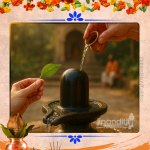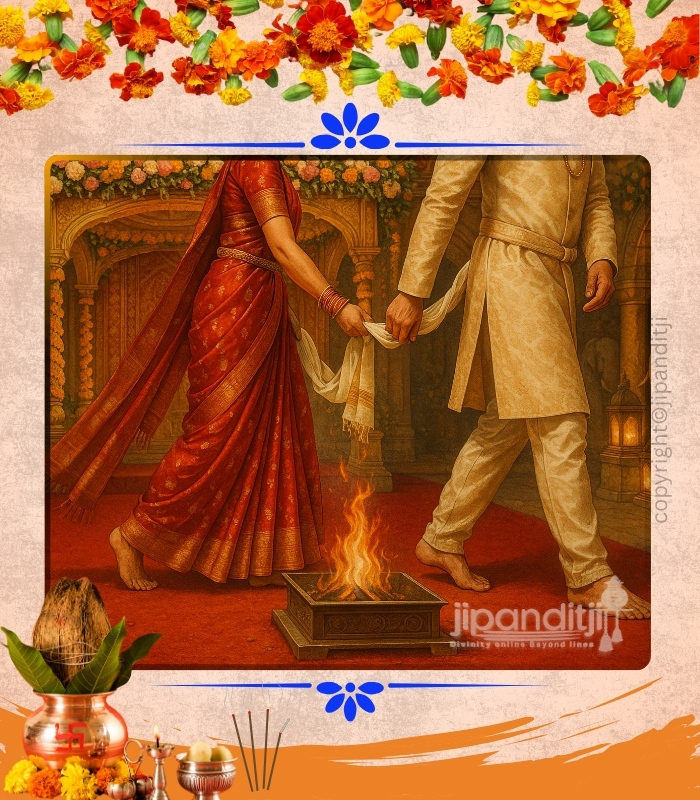The Sanatan Vedic Vivah Sanskar is a meticulously curated package designed to facilitate the performance of a complete Vedic Hindu marriage ceremony in accordance with shastric prescriptions and ancient traditions. Marriage is one of the most significant milestones in an individual’s life. In the Hindu tradition, it marks the sacred transition from Brahmacharya Ashram (the student phase) to Grihastha Ashram (the householder phase), symbolizing a new chapter of responsibility, companionship, and dharma.
The Vivah Puja (Wedding Puja) is performed to invoke divine blessings from various deities for the couple’s prosperous and harmonious life together. Through Vedic rituals, the couple seeks the presence and grace of Gods and Goddesses to bless them with love, stability, and spiritual unity.
Vivah – A Sacred Samskara
In Hinduism, marriage is not just a social contract—it is a samskara (sacrament). The Vivaha Samskar is one of the sixteen major samskaras that sanctify key life events. It is a spiritual commitment that binds two souls and their families, destined not only for this life but across lifetimes.
Marriage in Hindu culture carries profound spiritual, social, and cosmic significance. It fulfills the essential duties of:
- Continuing the family lineage
- Upholding Dharma (righteousness)
- Performing ancestral rites
- Serving society and God through a righteous household
By participating in this sacred ritual, the couple aligns themselves with divine order, setting the foundation for a life of balance, devotion, and mutual growth.
Marriage Rituals in Hindu Tradition
Hindu marriage is not merely a union of two individuals—it is a sacred rite that binds two souls in a lifelong commitment of dharma (duty), artha (prosperity), kama (desire), and moksha (liberation). While the specific customs may vary across regions, languages, and communities, the core structure of Hindu marriage ceremonies generally includes three main stages:
Pre-Marriage Rituals (Purva Samskara)
The pre-marriage phase begins with establishing mutual consent and alignment between both families. Key rituals include:
- Family Meet & Matchmaking: A formal meeting at the bride’s home where the prospective bride and groom interact. Once both agree, the families proceed with arrangements.
- Lagna Patrika (Formal Marriage Agreement): A written declaration marking the agreement and auspicious time for the wedding.
- Venue Selection & Invitations: Booking of the wedding mandap (venue), preparing guest lists, designing and printing invitation cards.
- Gift Exchange & Preparations: Mutual exchange of symbolic gifts and clothes, discussion of dowry (if culturally practiced), and allocation of duties between the two families.
Marriage Rituals (Vivaha Samskara)
This is the main wedding ceremony, often extending across 1–3 days depending on local customs. Some common rituals include:
- Ganesh Puja: To invoke Lord Ganesha and remove all obstacles.
- Kanyadaan: The sacred act where the bride’s father gives his daughter’s hand to the groom.
- Mangal Pheras: The couple walks around the sacred fire (Agni) seven times, taking vows with each round.
- Saptapadi (Seven Steps): The most crucial ritual where the bride and groom take seven steps together, symbolizing their shared journey of life.
- Sindoor & Mangalsutra: The groom applies vermillion to the bride’s forehead and ties the sacred thread (Mangalsutra), sealing the marriage.
Post-Marriage Rituals (Uttar Samskara)
After the wedding, a set of post-marriage traditions help integrate the bride into her new family:
- Griha Pravesh: The bride’s ceremonial entry into her new home, welcomed with traditional aarti and blessings.
- Reception & Community Feast: A celebratory gathering hosted by the groom’s family to introduce the bride to the community.
- Blessings & Rituals for Prosperity: Additional pujas for marital harmony, prosperity, and a blissful start to their new life.
Key Highlights:
- Complete Ritual Manual (संस्कार प्रक्रिया): Includes every step from mandap sthapan to saptapadi, with detailed descriptions and spiritual meanings behind each mantra and ritual.
- Sacred Material Kit (पवित्र सामग्री): Contains all essential items including havansamagri, pooja items, vedic samagri, and ceremonial offerings—sourced and prepared under Vedic guidelines.
- Scriptural Authenticity: Rituals and mantras based on Manusmriti, Smriti Granthas, and Vedic Scriptures, preserving the sanctity of the saptapadi-based vivah.
- Sanctified Marriage Ceremony: Emphasis on sacred commitments, spiritual bonding, and the sanctity of marital duties (पातिव्रत्य and एकपत्नीव्रत) under divine witness (Agni & Devatas).
What’s Included:
Pre-Marriage Rituals (पूर्वविधि):
- Mandap Sthapan (मण्डप स्थापना)
- Haridra Lepan & Kankan Bandhan
- Ganesh, Navagraha, Matrika, and Kalash Poojan
- Nandishraddha, Prayaschit, Panchang Poojan
Marriage Day Rituals (मुख्य विवाह विधि):
- Kanyadaan with Vedic Sankalp & Mantra
- Panigrahan, Ashmarohan, Lajahom, Saptapadi
- Granthibandhan, Sindoor Daan, Hridayalambhan
- Homa rituals including Jayahom, Swishtakrit, Bahihom
Spiritual Symbolism:
- Surya & Dhruva Darshan
- Sacred vow exchange (Saptapadi & Vachan)
- Vishnu-Lakshmi symbolism of bride and groom
- Invocation of Devtas, Pitrs, and Rishis for blessings
Pooja Samagri (हवन सामग्री):
- Kalash, Panchapatra, Ashtagandh, Navgraha Samidha
- Ghee, Guggal, Rice, Til, Jau, Chandan, Pushp
- Sindoor, Haldi, Supari, Ittra, Mishri, Paan, Kapda
Special Vedic Materials:
- Yajnopavit, Sacred Grass (Kusha), Gomutra Samagri
- Purna Patra Set, Havan Kund (10″x10″ copper), Mandap tools
Spiritual Benefits:
- Establishes Dharma, Artha, Kama, Moksha (Purusharth Chatushtaya)
- Fulfills Pitru Rina, Deva Rina, Rishi Rina through sacred grihasthashram
- Strengthens marital bond with spiritual purity and eternal love (Saat Janmon ka Bandhan)
- Mantra shakti and agni sankshep ensure divine blessings and righteous progeny












Meera –
Even our skeptical relatives were moved by the sincerity and devotion of the pandits. It elevated our wedding experience beyond expectations.
Meera & Kartik, Chandigarh
Pradeep –
We had guests from overseas and they were touched by the purity and solemnity of the ceremony. This package gave us a true Vedic wedding experience.
Pradeep & Meena, Hyderabad
Madhav –
A sacred experience! The Saptapadi and other core rituals were conducted just as the shastras prescribe. We felt immense positivity and blessings throughout the day.
Madhav & Anjali, Bangalore
Neelam –
It was more than a wedding — a spiritual journey for both of us. The mantras, rituals, and energy were so powerful.
Neelam & Harsh, Indore
Rohan –
Our wedding ceremony turned out to be deeply spiritual, authentic, and beautiful. The pandits were very well versed in Vedic mantras, and every ritual flowed perfectly.
Rohan & Priya, Mumbai
Pooja –
We got many compliments from elders and guests. They said it felt like an old-fashioned traditional wedding but with modern planning. Very happy with the outcome.
Pooja & Nitin, Bhopal
Sunita –
What impressed me most was the attention to detail. The samagri (ceremony materials) arrived on time and were of premium quality. The ceremony was dignified and uplifting.
Sunita & Deepak, Kolkata
Rahul –
From booking to execution, everything was professional. The pandits showed up well-prepared. Our wedding day remains one of the most memorable days of our lives
Rahul & Swati, Jaipur
Akash –
Even though we are living abroad, the guidance for rituals and pronunciation was clear and easy to follow. It brought our families close.
Aakash & Simran (NRI, UK)
Sangeeta –
“The rituals were explained clearly to us beforehand, and our families loved how smoothly things proceeded. It felt like a traditional temple wedding at home.”
Sangeeta & Arjun, Chennai